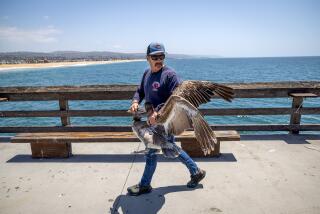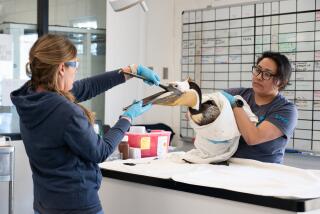Re-coop-eration for pelicans
Emerging from dog crates facing the open ocean, eight rehabilitated brown pelicans padded down a Cabrillo Beach boat ramp Friday on absurdly short legs, wings flapping hard to gain lift as they rose into the air.
They were among about 130 juvenile pelicans discovered, emaciated and ill, in the last two months in a variety of unexpected places from Long Beach to Santa Barbara -- in backyards, condominium complexes and shopping mall parking lots.
The big brown birds known for flying over beaches in formation were admitted for special care at the International Bird Rescue Research Center in San Pedro.
“We’re being inundated with as many as a dozen pelicans a day,” said Jay Holcomb, executive director of the center. “We believe it’s because pelicans have done well this year and produced lots of young.”
Therefore, he added, “the high number of ailing birds is actually a good sign.”
Dan Anderson, professor of wildlife, fish and conservation biology at UC Davis, explained the problem.
“A lot of these birds are basically starving to death,” he said. “After three months of being fed in their breeding colonies, this year’s young pelicans are beginning to disperse from their nests with enough baby fat to tide them over for a few months while they learn to fish.”
But after a few months, Anderson said, the birds “use up all that baby fat. That’s when they start showing up at rehabilitation centers.”
Young pelicans, which usually don’t fly as far out to sea, can be identified by their brown heads and white bellies. Inexperienced birds often become interested in fishermen for food, diving on their bait and becoming entangled in lines or caught on fishhooks.
Brown pelicans plunged to near zero population growth in the 1960s and 1970s. DDT residue in the fish that the pelicans ate weakened the shells of their eggs, which broke easily.
When DDT was banned in the United States in 1972, the species started to recover. In February, the Interior Department announced a proposal to remove brown pelicans from the endangered species list.
More than 70,000 breeding pairs of pelicans inhabit California and Baja California, and total numbers have surged to about 620,000 birds along the West Coast, the Gulf Coast and Latin and South America.
Now, bird rescue centers have their work cut out for them. SeaWorld San Diego, which has received 70 brown pelicans in need of rehabilitation so far this year, released an additional 10 of the birds Friday.
The San Pedro center has admitted 20 pelicans since Sunday, according to rehabilitation manager Julie King.
“It’s a little busy around here right now,” said King, lifting a white sheet to examine a pelican being warmed by a floor heater. “This guy has had trouble thermal regulating.”
The center’s weakest pelicans need electrolytes and protein-rich nourishment, which is squirted down their gullets with syringes, or administered intravenously. Two pelicans were awaiting surgery to remove fishhooks that had been swallowed.
It costs about $20 a day to rehabilitate a pelican, with most of that expense going for smelt and anchovies they eat. The center offers a “Pelican Partner” adoption program to cover costs.
“Will they survive after we let them go? Hard to say,” King said. “But I do know this; we are giving these birds a second chance to get back in the wild and figure it all out.”
The eight pelicans released Friday were scooped from an aviary pool with a fishing net, then placed inside the dog crates to be taken to the beach in a van.
At the water’s edge, King tapped the side of the crates to encourage the pelicans to waddle out. “A little shy?” she asked as they filed out and, with heavy flaps followed by a long glide, the pelicans landed together about 30 yards offshore. A few minutes later, they were diving with open mouth-pouches to scoop up fish.
“That’s a real good sign,” King said.
--
More to Read
Sign up for Essential California
The most important California stories and recommendations in your inbox every morning.
You may occasionally receive promotional content from the Los Angeles Times.











